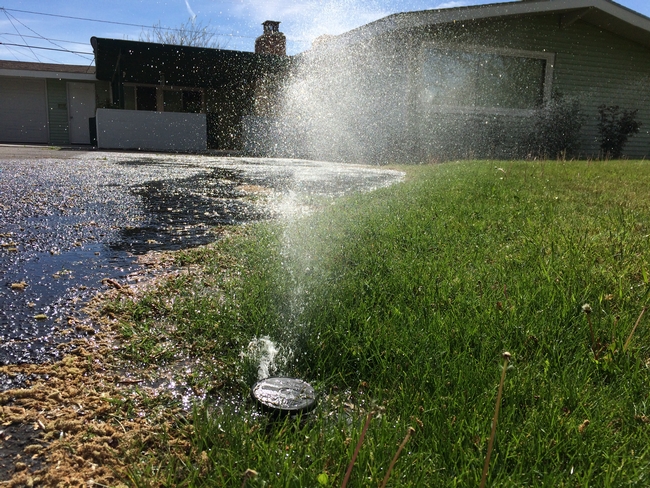As I was driving my kids to school recently, I noticed that a landscape on the way was irrigating its dormant turf. It had rained the night before. That seemed really unnecessary. Later that day I saw another landscape (with green grass) had a head spraying out into the street. I see irrigation problems almost every day but for some reason that memory stuck.
As a community, we tend to irrigate our landscapes poorly, but we can do better. Ideally we should apply just what our plants need plus maybe a little extra to make up for variability in our sprinkler system. It's not uncommon for a landscape in Bishop to use 2 or 3 times the water it needs. Assuming that water makes it on to the lawn. Last summer there was a small creek along the curb in my neighborhood every morning from someone's broken irrigation up the street. And to be fair, I have a head that often gets flipped backward and then waters the driveway.
Maybe in a future post we can cover how much water our lawns need and how often to run the system, but today I think a good place to start is how to make sure your system is working correctly. Rain Bird has a nice spring checklist, but the process should involve a bit more.
A good practice is to begin the season with an irrigation audit. This is a process where we check to make sure everything is working as it should, and we check the output of our sprinklers to make sure they are uniform. Uniform application saves water since we don't have to over apply water to get the dry places wet enough.
All irrigation audits start by running the system and making sure sprinkler heads are working and pointing over grass. This is usually simple to address. You may need a small screwdriver to make some adjustments but that's about it.
From there you can choose how complicated you want to be. Commercial turf managers will audit their systems using at least 20 special catch cans to measure the system's output and variability. That's probably over-kill at home.
Oklahoma State Cooperative Extension has a very simple version of this test that will tell you each sprinkler zone's output in inches per hour using tuna or cat food cans. This will allow you to set your sprinkler system to water just the amount the lawn needs rather than "15 minutes every day" type scheduling. They even include a short video. SIMPLE AUDIT LINK.
If you use this system I'd recommend looking at each can to see if they are about the same level. If they vary a lot, you may need to consider some maintenance on the system. As a rule, most sprinklers are designed to have head-to-head coverage in their pattern. If your system does something else--that's common around Bishop--expect a lot more variability.
At the very least, run your system and watch it for a few minutes. Put a catch can or 2 of any type with straight sides on for one cycle to confirm how much water you're applying. Sticking a ruler in is a good way to measure. You may be applying more or less than you think!
If you are interested in figuring out out to properly schedule up your irrigation, the Master Gardeners can help with that, but we will need to know each zone's output in inches per hour. You can contact us at immg@ucanr.edu.
